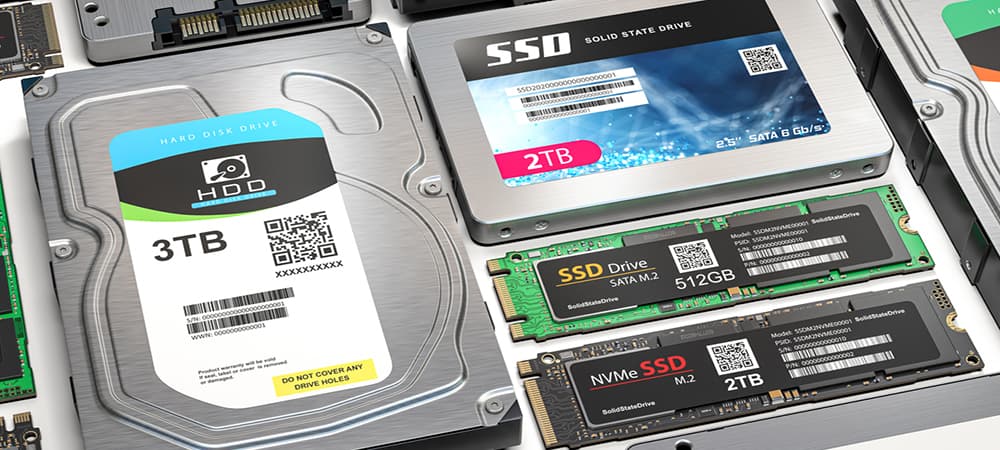We use cookies to offer you a better experience. For more information on how we use cookies you can read our Cookie and Privacy Policy.
How to Choose the Best Hard Drive Computer Storage for You: A Buying Guide
March 15, 2021

When buying a new computer or upgrading your current PC, you’ll notice a growing number of storage options available. And it’s not just that you can choose from different-sized hard drives, either. With solid-state drives, hard disk drives, and hybrid options on the table, it’s tough to know what to choose these days.
In our hard drive buying guide, we’ll explore the storage formats available for consumer PCs, with an emphasis on which you may prefer based on your usage. We’ll also outline the typical costs and associated features, and explain how you can manage your storage system.
After all, the right storage configuration can have a drastic impact on your day-to-day computing experience with faster loading, improved response times, and more storage space.
Most common storage configurations
Computer storage is generally configured in one of three ways:
- Hard-disk drive (HDD)
- Solid-state drive (SSD)
- Hybrid storage (HDD + SSD)
SSD is used more and more frequently, thanks to a gradually lowering price point over the past couple of years. While you may associate the HDD with older devices, that isn’t always the case and it’s still the best choice for some applications. In fact, the ideal scenario for some users may be the hybrid hard drive, because it gives you the speed of an SSD with the massive capacity of an HDD.
Let’s now look at how each format works, then get into the most important advantages of each to keep in mind as you shop.
HDD buying guide
What is an HDD?
A typical HDD uses a spinning magnetic disk to manage data, with a magnetic head mounted to an actuator arm to read and write data. The system resembles a turntable, but provides greater complexity. With multiple disks to access, HDD storage uses a control device to help your computer quickly target where existing information is stored. So when you access a program or file, the HDD controller directs the actuator arm wherever it needs to go.
Advantages of an HDD
One of the biggest advantages of an HDD is its long track record on the market. This dynamic may shift toward the SSD over time but, for now, HDDs have decades of experience in research, manufacturing, and use by consumers. That means they’re often easier to troubleshoot.
With a better base capacity, maximum capacity, and cost per unit of storage, the HDD is generally considered the most affordable option. In many cases, comparably-sized SSDs are dramatically more expensive. Some laptops may not even support the same capacity in both formats, making it harder to configure your PC with the amount of storage you need if you prefer one over the other.
The HDD is also considered to have higher stability. This difference may not be significant in the lifespan of most consumer devices, but an external HDD is often preferred for archival purposes and institutions. We’ll talk more about that below in our section on hybrid storage.
Who should use an HDD?
The HDD is ideal for budget shoppers. When your primary goals are the highest capacity at the lowest possible upfront cost, you’ll definitely save with an HDD. The SSD may be more “modern,” but a robust HDD is a great, affordable storage solution for both professionals and families.
Key features:
- Most affordable per gigabyte
- Higher maximum capacity
- Longer track record
- Higher stability
SSD buying guide
What is an SSD?
An SSD accomplishes the same function as an HDD without the complex moving parts. Instead of spinning disks accessed via an actuator arm, an SSD uses a collection of flash memory chips to store data. This shift is connected to virtually all of its advantages.
The technology behind the SSD has roots in smaller applications, and it’s expected to make more inroads against the HDD when it comes to consumer computing technology. As prices decline and the technology improves, you can expect more affordable and powerful starting SSD options.
Advantages of SSD
The smaller, simplified format of SSD storage has numerous benefits. The lack of moving parts means that SSDs provide substantially faster read, write, and load speeds compared to an HDD. A lack of physical movement also protects against impact damage, which minimizes vulnerability following drops or falls.
The smaller size and improved efficiency in an SSD also leaves more room in PC builds which gives developers, manufacturers, and DIY users a lot more room to work with. They use less power, too, which can translate into a smaller electrical bill for heavy users.
SSDs are also unaffected by magnetic interference and generate less heat. Less heat means higher efficiency, decreased wear, and more space than you may otherwise use for cooling an HDD. Without fans and moving parts, SSDs also operate much more quietly than an HDD.
Who should use an SSD?
An SSD is great for gamers and professionals who need fast program load times, as well as students who may be juggling a large workload and tight schedules. Historically, SSD storage has had upper limits that don’t rival HDDs, but this is changing over time, especially with laptops. This improved access to more storage space means the SSD is becoming increasingly suitable for general users, too.
Key features:
- Best response times
- Better energy efficiency
- Quiet running
- Less vulnerable to impacts
Hybrid storage (HDD + SSD)
What is a hybrid storage configuration?
In a hybrid storage configuration, manufacturers pair an HDD with an SSD to provide the best of both worlds. The SSD typically handles routine read and write activities while the HDD component is used for bulk storage.
Advantages of hybrid storage
While SSD prices continue to drop, hybrid storage is a great way to see those benefits now. With hybrid storage, you get the primary benefit of an SSD – speed, efficiency, and reduced noise – when accessing your most frequently used files, and an HDD for those files you don’t need as often. It’s a great solution for optimizing a shared device or work computer, though it generally doesn’t substantially improve the user experience for gamers.
For large files like software, personal archives, and backups, the hybrid setup uses the HDD. This makes the overall process more efficient, primarily because both the HDD and SSD are subject to less overall strain. A major benefit of using a hybrid storage solution is that it should last longer, so you’re getting the most out of your purchase.
While a solely SSD system will run faster, hybrid storage is an ideal compromise, especially if you’re upgrading an existing desktop storage system or want an interim solution while you wait for better SSD pricing. Some modern devices ship preloaded with hybrid storage, too, either as the standard choice or a custom option.
To learn more, check out our What is a Hybrid Hard Drive? article for a thorough explanation and more comprehensive product comparisons.
Who should use hybrid storage?
If you need lots of storage and a responsive interface, you may want to consider hybrid storage. It’s also especially well-suited to DIY users looking to improve an older or home-built system. And you can extend the life of still-useful devices or avoid major migrations, both of which are big benefits for professionals and institutional users.
Key features:
- Blends HDD + SSD features
- Minimizes material waste
- Response times exceed standalone HDD
- Great for upgrades
How to add more storage
Whether you’d like to add an extra hard drive to your desktop or install a new SSD, the process is similar. Often you can simply add a second (or third) drive in a desktop if your motherboard will accommodate it. Laptops, on the other hand, generally have room for only one drive, meaning you’ll have to replace existing storage with a new hard drive if you want better speeds or more space.
Check out our guide to How to Replace a Hard Drive and Reinstall an Operating System for information on changing out an HDD, plus how to handle your data and OS. Or, if you’re working with an SSD, consult our guide on How to Install a Solid-State Hard Drive (SSD) for help.
Want a less hands-on solution? Consider using an external hard drive or cloud-based storage. As long as you find a compatible device with the right capacity, external drives are an easy way to add storage without opening up your PC.
Does my computer have SSD or HDD storage?
Want to find out what type of storage in your computer right now? As a Windows user, the procedure is fast and easy:
- Click the Windows/Start icon at the lower-left of your desktop.
- Click the gear-shaped Settings icon.
- Select the “System tab.”
- Click the “Storage tab” on the left sidebar.
- Scroll down to “More storage settings” and select the Optimize Drives option.
- Check Media type from the new window to see what format your device uses.
For an even easier solution, you could always just listen to your computer the next time you load an application or restart it. HDD storage relies on mechanical components, so you should hear your drive whirring as the disk spins for reading. If you don’t hear anything, chances are your device uses SSD storage.
Where is the hard drive in my computer?
Storage components are easy to locate regardless of format.
- In a desktop PC, the drives are usually stored somewhere accessible, like near the front of the case. They are often mounted with metal retention clips or in a drive cage to keep them secure.
- If you own a laptop, the hard drive is typically accessible from underneath. Unscrew a few screws to remove the bottom of your laptop case, and you should have access to all your components.
Summary
When it comes to choosing which storage is right for you, the benefits are pretty simple to remember. An HDD has cost and capacity advantages, but the SSD is speedy, built for users who prioritize loading times, and is less susceptible to damage from accidental drops.
And if you want capacity and speed at once, hybrid storage is a safe bet. It’s also important to remember that storage technology is changing very quickly. In just a year or two, this hard drive buying guide may look a lot different, so keep an eye out for updates.
About the Author: Dwight Pavlovic is a contributing writer for HP® Tech Takes. Dwight is a music and technology writer based out of West Virginia.
Article reposted with permission from HP Tech Takes






